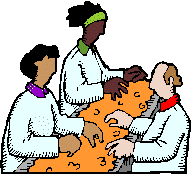Assembly Line
Social Studies Lesson Plan
Students will understand the benefits of using the assembly line method of production rather than the conventional factory method.

tagboard templates of animals - You will need to make these by breaking 6 or 7 different animals into "sections" and making a template for each one. For example, with a giraffe you would make 1 leg (it can be traced 4 times), the main body, the neck, the head, and the tail. You will need one template per student-5 or 6 students should get the same template. construction paper glue crayons timer(s)
- Give each student a template. Explain to them that they will be tracing the template onto construction paper, cutting out the pieces, and putting together with glue and decorating it. Set a timer for 15 minutes and have the students make as many animals as they
- can, but stress that their "product" needs to be complete-no uneven edges or sloppy work! Tell them that their paper animals need to be sellable.
- After 15 minutes, make a simple chart on the chalkboard to tally the number of completed products. Tally by type of animal (lion, hippo, giraffe) and by total number of animals produced.
- Have students get into groups based on the type of animal they worked on in the previous activity (lions all together, hippos all together, etc.).
- Tell students that they are going to be doing the same activity, but by working together using the assembly line method. This means that they will each have a particular job in the line to make the finished product.
- Have them divide themselves up into jobs-with five students per group: a. One tracer b. Two cutters c. One gluer d. One decorator If you have more students, they should assign them other jobs, i.e. tracing or decorating.
- Set the timer for 15 minutes again and let your students start their assembly line.
- Once again, tally and compare the difference between the conventional, one-man assembly method and the assembly-line method.
Discuss with students the benefits of using the assembly-line method. They should recognize the difference in production volume between the two methods. Have them talk about which method they prefer and what they noticed about the quality of the products coming from both of the production lines. Where in real life is the production line used? Why is it necessary in this technological age?
- You may want to have them look up some historical facts about the first successful uses of this manufacturing method and how it helped start and shape the Industrial Revolution in the United States and Europe.
- You may want to choose animals of one world region, such as rainforest or farm animals. Then you can use the animals in a decorative mural or you can use them throughout the study for charts, graphs, and other assignments.
- Evaluation: Were students able to follow directions correctly? Did they work together harmoniously and efficiently? Notice which students are able to explain the benefits of the assembly-line method and which students are able to give real-life situations where this method is used.


